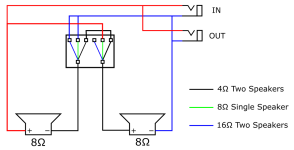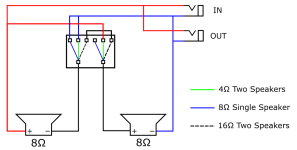I've been fighting GAS for a while on buying a Amp Head... Or is this AHAS ?
Anyway, pulled the trigger recently and I'm now planning a Cabinet build. Now for some reason, I can't do something simple. My thought is: I want a highly flexible Amp Cabinet. So I came up with this wiring to be as versatile as possible:

The idea is a 3-way switch that would allow me to run it is 2 different mode:
Pos 1: Two speaker in parallel runnig at 4 ohms
Pos 2: One speaker running at 8 ohms
Pos 3: Two speaker running in series at 16 oms
Now here's my questions:
- Did I get the wiring right ?
- What type of switch would allow me to do this ? (Does it even exist?)
I know, I'm a bit stupid, but hey who wants to do something simple ?
Anyway, pulled the trigger recently and I'm now planning a Cabinet build. Now for some reason, I can't do something simple. My thought is: I want a highly flexible Amp Cabinet. So I came up with this wiring to be as versatile as possible:

The idea is a 3-way switch that would allow me to run it is 2 different mode:
Pos 1: Two speaker in parallel runnig at 4 ohms
Pos 2: One speaker running at 8 ohms
Pos 3: Two speaker running in series at 16 oms
Now here's my questions:
- Did I get the wiring right ?
- What type of switch would allow me to do this ? (Does it even exist?)
I know, I'm a bit stupid, but hey who wants to do something simple ?



